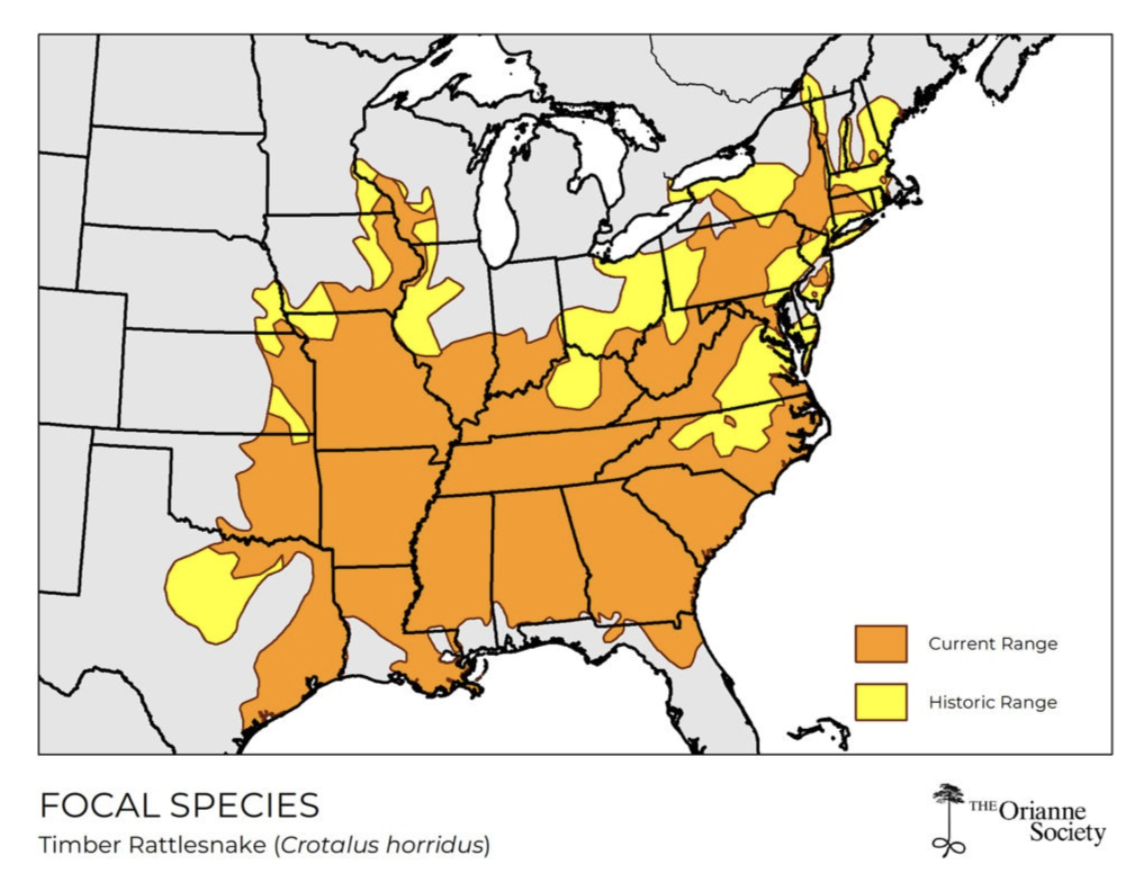Understanding and Celebrating the Timber Rattlesnake
By Quentin Miller
In August 2022, Sarah Buckner captured a beautiful timber rattlesnake traveling across a hiking trail near Snoopers Rock. The video quickly went viral given its size and location. While it may be quite intimidating to witness one out in nature, they are equally intimidated by your presence and have no interest in engaging with you unless they feel threatened. The snake observed in the video was an adult timber rattlesnake that appears to be ~40 inches long. Adult snakes reach an average length of 40-52 inches depending on their sex (males being larger than females). Claims of timber rattlesnakes being longer than 6-7 feet are often exaggerated and unlikely. Timber rattlesnakes can be identified by the classic triangular head, tail rattle, and Chevron or W-shaped crossbands running down the body. The physical coloration of the snake varies depending on geographic location. There are two distinct color phases (light and dark) for timber rattlesnakes, however, individual’s color can often be a combination of the two phases.
Range Map of Timber Rattlesnake
Timber rattlesnakes call the Tennessee River Gorge and the surrounding areas home. Researchers estimate that their current range spans from New York all the way to Florida and west into states such as Kansas and Texas. Historically, timber rattlesnakes were found in the states of Delaware, Rhode Island and Maine but have since been extirpated by humans through state sponsored eradication programs. Today, it is illegal to kill any rattlesnakes in Tennessee (https://www.tn.gov/twra/guide/hunting-regulations.html). Public perceptions have positively changed over time, but the species is still misunderstood. Timber rattlesnakes have been a popular symbol of American unity and freedom. Benjamin Franklin first used this snake as a media icon during the French and Indian War of 1754-1763. The snake representing the 8 colonies, weak when separated but a formidable force when unified. The snake later became the famous icon of the “Don’t Tread on Me” flag during the Revolutionary War.
Timber rattlesnakes do not seek out or intend on striking humans. They prey on small rodents, amphibians, birds , and other similarly sized critters. They utilize unique, heat-sensing pits on their head to locate prey and envenomate them. Snakes will often forage along dry, sloped deciduous forests. Dens are often located in rocky areas or the bottoms of cliffs and slopes. The home range for males is estimated to be about 222 acres. The females’ ranges are much smaller at 1/3 of the males’ range and become even smaller during gestation periods. They are a late maturing species with females not reaching sexual maturity until 9-10 years and the males being 4-6 years of age. Females will only reproduce every two years on average in most southern states due to the high biological costs of reproduction. Breeding takes place during early summer to late fall and the females will give live birth to 5-14 individuals. The low fecundity and late sexual maturity of this species certainly puts emphasis on the protection of adult snakes. The Tennessee Wildlife Resource Agency has listed this species as a population in decline throughout the region citing habitat loss, road collisions, and human persecution as driving factors.
Safe Practices for Walking on the Trail
While you are highly unlikely to see a snake on your next hike, it is best to practice some safe hiking tips. Wear closed toed shoes and long pants while hiking. Always scan your surroundings and watch where you are stepping, especially around large rocks or logs. Do not reach or place your hands into crevices that are not entirely visible. If you must detour from the trail, avoid heavy underbrush and return to the trail as soon as possible.
What should I do if I see a Timber Rattlesnake on the Trail?
Back away from the snake. A good rule of thumb is to back away at least 10 steps from the snake.
DO NOT try and move it with a stick as this will only agitate them and increase the risk of a strike.
There is no need to yell or wave at the snake. Timber Rattlesnakes have internal ears that do an excellent job of sensing vibrations in the ground.
Wait for the snake to continue along its path until it is safe to pass.
If the snake is not moving from the trail, determine a safe, alternative route around the snake.
The Tennessee River Gorge holds a healthy population of this species. By understanding these creatures and the value they bring to the ecosystem, we can live harmoniously with them and celebrate their presence rather than their absence. For more information, visit the Orianne Society.


